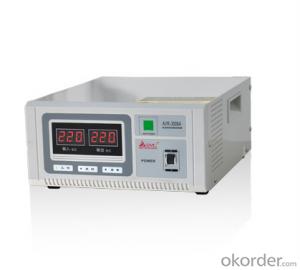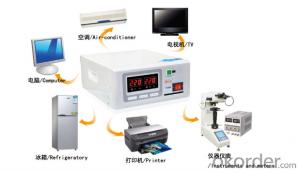cvoltage stabilizer ircuit diagram 5kv automatic voltage stabilizer
- Loading Port:
- China main port
- Payment Terms:
- TT OR LC
- Min Order Qty:
- 20 carton
- Supply Capability:
- 10000 carton/month
OKorder Service Pledge
OKorder Financial Service
You Might Also Like
Unipower circuit diagram 5kv automatic voltage stabilizer

Product Description

| Model | AVR-1008A | AVR-2008A | AVR-3008A | AVR5008A |
| Rated power | 1000VA | 2000VA | 3000VA | 5000VA |
| Display | LED or LCD, depends on user's choice | |||
| TECHNOLOGY | ||||
| Technology | CPU Based Digital Circuit + Transformer + Ralays | |||
| Efficiency | 98% | |||
| Phase | Single | |||
| INPUT | ||||
| Input voltage range & frequency | 140~280VAC/Same as AC | |||
| OUTPUT | ||||
| Output voltage range | 220VAC±10% | |||
| DISPLAY | ||||
| LED digital display status | Input voltage, output voltage | |||
| LED display status | Normal, Display, Fault | |||
| PROTECTION | ||||
| Protections | Over & low voltage, overload, high temperature, short circuit | |||
| ENVIRONMENT | ||||
| Environment of performance | Temperature 0℃~40℃, Humidity 20%~90% | |||
| Noise level | Less than 40dB | |||
| PHYSITAL | ||||
| (kg) / Net weight (kg) | 4.5 | 6.0 | 10 | 13.0 |
| (mm) / Unit dimention (mm) | 251*255*120 | 315*255*120 | ||

1. Wide range of input voltage
The UPS can offer normal and stable service voltage under its input voltage range. When the input voltage is out of its range the machine will switch to battery mode automatically to keep the output power in order to protect the equipment, such as computers, ensure they will not be damaged by the over high or over low voltage, users can continue the operation of equipment for a while or save the data on computers while the power network is abnormal.
2. Wide range of AVR(Automatic voltage regulation)
In the product’s input voltage range and under 3 steps of intelligent AVR function, it can provide a stable output voltage.
3. Automatic self detection when UPS on(LED).
Before the UPS on, red, yellow, blue LED will light up two times by cycle turns, after self detection UPS switch to AC mode/battery mode or working mode.
4. Silence function
In the "battery mode", shortly press the switch to turn off the buzzer. But the battery is about to run out or the load is too heavy, the buzzer sound cannot be muted.
5. Overload protection
In the battery mode, output voltage turn down correspondingly when it is overload, after the capacity of load is lower than the rated power then output voltage will back to rated value, it ensures the UPS will not shut down by abrupt overload which caused by surging current during the computer is working and other equipment is added.
6. Short circuit protection
When the mis-operation caused the load short circuit or computer failure (such as power tube breakdown of switch) cause short circuit, the UPS will shutdown automatically for protection.
7. The low current switch
This UPS adopts low current switch to extend the service life which is longer than conventional battery and high current switch in AC current path.
8. Automatic charging
There are two charging mode, charging time is faster than ordinary charging mode, higher efficiency, and greatly prolonging the service life of the battery.
9. With a bypass output
Independent bypass output socket for external printers or scanners of computer peripherals, with surge protection of the load.
- Q:Can a solar energy system be installed on a barn or agricultural building?
- Certainly, it is possible to install a solar energy system on a barn or agricultural building. In fact, an increasing number of farmers and agricultural businesses are embracing solar energy to fulfill their electricity requirements. There are numerous advantages to installing solar panels on barns or other agricultural structures. To begin with, barns and agricultural buildings often boast spacious rooftops or open areas, which provide ample room for the installation of solar panels. This enables efficient utilization of solar energy and can result in the generation of a substantial amount of electricity. Additionally, the installation of a solar energy system on a barn or agricultural building can assist in reducing or even eliminating electricity costs for the property. This is particularly advantageous for farmers, who typically have high energy consumption due to the operation of various equipment such as irrigation systems, lighting, ventilation, and machinery. Furthermore, solar energy systems are ecologically friendly and produce clean, renewable energy. By installing solar panels, farmers can significantly decrease their carbon footprint and contribute to a more environmentally sustainable future. Moreover, many governments and utility companies offer financial incentives, grants, or tax credits to encourage the adoption of solar energy systems. These incentives can help offset the initial installation costs and make investing in solar energy more affordable for farmers. Lastly, a solar energy system on a barn or agricultural building can serve as a backup power source during power outages, ensuring uninterrupted critical operations. In conclusion, installing a solar energy system on a barn or agricultural building is not only possible but also highly advantageous. It enables farmers to reduce energy costs, minimize their environmental impact, and potentially generate additional income through incentives or by selling excess electricity back to the grid.
- Q:Can solar energy systems be used for powering factories?
- Yes, solar energy systems can certainly be used for powering factories. Solar panels can be installed on the rooftops or open spaces around factories to capture sunlight and convert it into electricity. This renewable energy source can provide a significant portion or even the entire energy needs of a factory, reducing reliance on non-renewable sources and lowering carbon emissions.
- Q:Can solar energy systems be used for powering electric vehicle showrooms?
- Certainly, solar energy systems have the capability to power electric vehicle showrooms. Solar energy, which is both clean and renewable, can effectively supply electricity to a wide array of applications, such as commercial buildings like showrooms. By installing solar panels on the showroom's roof or surrounding areas, the sun's energy can be converted into electricity. This generated electricity can then be utilized to operate various functions within the showroom, including lighting, air conditioning, charging stations, and other electrical equipment. This not only decreases reliance on grid electricity, but it also aids in lowering carbon emissions and promoting sustainability. Moreover, solar energy systems can offer a cost-effective solution in the long term, as they contribute to reducing or eliminating electricity bills while providing a reliable and consistent power source.
- Q:Can solar energy systems be used for powering off-grid military operations?
- Yes, solar energy systems can be effectively used for powering off-grid military operations. Solar panels can generate electricity in remote locations, reducing dependency on traditional fuel sources and ensuring a reliable power supply. This sustainable and renewable energy source helps enhance operational flexibility, reduce logistical challenges, and decrease the environmental impact of military operations. Additionally, solar energy systems can be easily deployed, provide silent operation, and require minimal maintenance, making them suitable for various off-grid military applications.
- Q:What is the role of solar trackers in solar energy systems?
- The role of solar trackers in solar energy systems is to optimize the efficiency and output of solar panels by tracking the movement of the sun throughout the day. Solar trackers automatically adjust the position of the panels to ensure that they are always facing the sun at the optimal angle, maximizing the absorption of sunlight and increasing the overall energy generation of the system.
- Q:Can a solar energy system power an entire household?
- Yes, a solar energy system has the potential to power an entire household. The capacity of a solar energy system to power a household depends on various factors such as the size of the system, the amount of sunlight available, the energy consumption of the household, and the efficiency of the solar panels. A properly sized and well-designed solar energy system can generate enough electricity to meet the energy needs of a household, including powering appliances, lights, heating and cooling systems, and other electrical devices. In some cases, excess energy produced by the solar panels can be stored in batteries for use during times of low sunlight or at night. Additionally, surplus electricity generated by the solar system can be fed back into the grid, allowing households to earn credits or receive compensation from utility companies. Therefore, with the right solar energy system setup, it is indeed possible to power an entire household solely with solar energy.
- Q:How much do solar energy systems cost?
- The cost of solar energy systems varies depending on several factors such as the size of the system, the location, and the specific components used. On average, a residential solar system can range from $15,000 to $25,000 after accounting for federal tax incentives and other rebates. However, it's important to note that prices have been declining rapidly in recent years, making solar energy more affordable and cost-effective in the long run.
- Q:Can solar energy systems be used in areas with limited access to solar junction boxes?
- Yes, solar energy systems can still be used in areas with limited access to solar junction boxes. In such cases, alternative solutions like off-grid solar systems or portable solar panels can be utilized to harness and store solar energy without relying on traditional junction boxes. These systems allow for greater flexibility and independence in utilizing solar energy, even in areas with limited infrastructure.
- Q:How do solar energy systems impact energy security?
- Solar energy systems have a positive impact on energy security as they diversify the energy sources and reduce reliance on fossil fuels. By harnessing the abundant and renewable sunlight, solar energy systems provide a stable and reliable source of electricity, decreasing the vulnerability to disruptions in fossil fuel supply chains. Additionally, the decentralized nature of solar power allows for distributed energy generation, reducing the risks associated with centralized energy systems. Overall, solar energy systems enhance energy security by promoting sustainability, resilience, and independence in the energy sector.
- Q:Can solar energy systems be used in residential apartments or multi-story buildings?
- Yes, solar energy systems can be used in residential apartments or multi-story buildings. They can be installed on rooftops or other available spaces to harness sunlight and generate electricity for individual units or shared common areas. These systems can help reduce energy costs, promote sustainability, and provide an environmentally-friendly source of power for residential complexes.
1. Manufacturer Overview |
|
|---|---|
| Location | |
| Year Established | |
| Annual Output Value | |
| Main Markets | |
| Company Certifications | |
2. Manufacturer Certificates |
|
|---|---|
| a) Certification Name | |
| Range | |
| Reference | |
| Validity Period | |
3. Manufacturer Capability |
|
|---|---|
| a)Trade Capacity | |
| Nearest Port | |
| Export Percentage | |
| No.of Employees in Trade Department | |
| Language Spoken: | |
| b)Factory Information | |
| Factory Size: | |
| No. of Production Lines | |
| Contract Manufacturing | |
| Product Price Range | |
Send your message to us
cvoltage stabilizer ircuit diagram 5kv automatic voltage stabilizer
- Loading Port:
- China main port
- Payment Terms:
- TT OR LC
- Min Order Qty:
- 20 carton
- Supply Capability:
- 10000 carton/month
OKorder Service Pledge
OKorder Financial Service
Similar products
New products
Hot products
Hot Searches
Related keywords





























